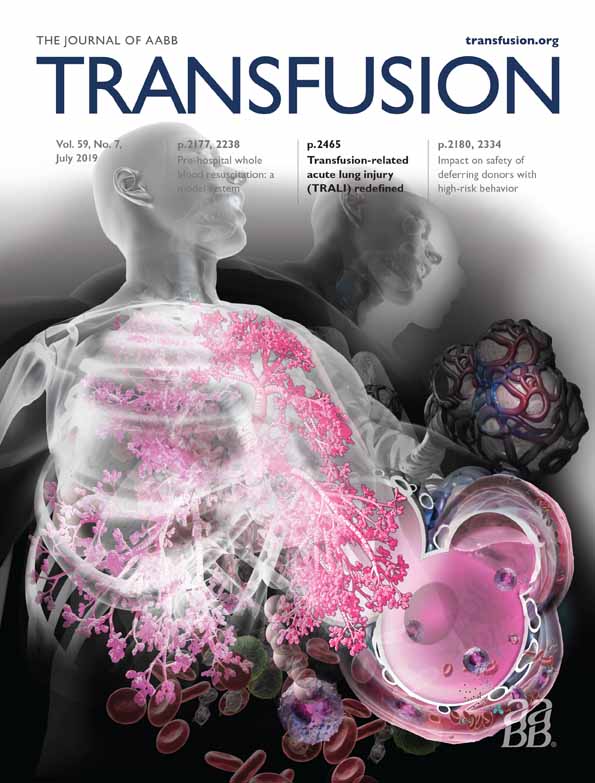REPORT OF NEW ALLELES OR ANTIGENS
A GYPB variant encoding an altered leader peptide leads to a weak S phenotype
Jacqueline Cote,
Jacqueline Cote
Canadian Blood Services, National Reference Laboratory, Toronto, Ontario, Canada
Search for more papers by this author Selena Cen,
Selena Cen
Canadian Blood Services, Centre for Innovation, Toronto, Ontario, Canada
Search for more papers by this author Katie Fennell,
Katie Fennell
Grifols Immunohematology Center, San Marcos, Texas
Search for more papers by this author Chantale Pambrun,
Chantale Pambrun
Canadian Blood Services, National Reference Laboratory, Toronto, Ontario, Canada
Canadian Blood Services, Centre for Innovation, Toronto, Ontario, Canada
Search for more papers by this author Donald R. Branch,
Donald R. Branch
Canadian Blood Services, Centre for Innovation, Toronto, Ontario, Canada
Department of Medicine, University of Toronto, Toronto, Ontario, Canada
Search for more papers by this author Gorka Ochoa-Garay,
Corresponding Author
Gorka Ochoa-Garay
Grifols Immunohematology Center, San Marcos, Texas
Address reprint requests to: Gorka Ochoa-Garay, Grifols Immunohematology Center, 201 Carlson Circle, San Marcos, TX 78666; e-mail:
[email protected].
Search for more papers by this author
Jacqueline Cote,
Jacqueline Cote
Canadian Blood Services, National Reference Laboratory, Toronto, Ontario, Canada
Search for more papers by this author Selena Cen,
Selena Cen
Canadian Blood Services, Centre for Innovation, Toronto, Ontario, Canada
Search for more papers by this author Katie Fennell,
Katie Fennell
Grifols Immunohematology Center, San Marcos, Texas
Search for more papers by this author Chantale Pambrun,
Chantale Pambrun
Canadian Blood Services, National Reference Laboratory, Toronto, Ontario, Canada
Canadian Blood Services, Centre for Innovation, Toronto, Ontario, Canada
Search for more papers by this author Donald R. Branch,
Donald R. Branch
Canadian Blood Services, Centre for Innovation, Toronto, Ontario, Canada
Department of Medicine, University of Toronto, Toronto, Ontario, Canada
Search for more papers by this author Gorka Ochoa-Garay,
Corresponding Author
Gorka Ochoa-Garay
Grifols Immunohematology Center, San Marcos, Texas
Address reprint requests to: Gorka Ochoa-Garay, Grifols Immunohematology Center, 201 Carlson Circle, San Marcos, TX 78666; e-mail:
[email protected].
Search for more papers by this author
First published: 30 March 2019
No abstract is available for this article.
CONFLICT OF INTEREST
The authors have disclosed no conflicts of interest.
| Filename |
Description |
| trf15295-sup-0001-Supinfo.docxWord 2007 document
, 67.8 KB |
Fig. S1. Results of signal peptide prediction engines SignalP and Signal-3L for full-length glycophorin B with a common (Ala) or variant (Val) residue at position p.19. The plots show results for the first 50 residues. Both engines predict a cleavage site for the common sequence between positions p.19 and p.20, and for the variant sequence, with a significantly-lower score, between p.21 and p.22.
Table S1. Flow cytometry results with control (U-, ss, sS, SS) and patient RBCs. For the secondary reagent, see Brief Methods
|
Please note: The publisher is not responsible for the content or functionality of any supporting information supplied by the authors. Any queries (other than missing content) should be directed to the corresponding author for the article.
REFERENCES
- 1Storry JR, Reid ME, Fetics S, et al. Mutations in GYPB exon 5 drive the S-s-U+var phenotype in persons of African descent: implications for transfusion. Transfusion 2003; 43: 1738-47.
- 2Von Heijne G. Patterns of amino acids near signal-sequence cleavage sites. Eur J Biochem 1983; 133: 17-21.
- 3Shoeman EM, Roulis EV, Perry MA, et al. Comprehensive blood group antigen profile predictions for Western Desert Indigenous Australians from whole exome sequence data. Transfusion 2019; 59: 768-78. https://doi.org/10.1111/trf.15047.
- 4Zhang Z, Henzel WJ. Signal peptide prediction based on analysis of experimentally verified cleavage sites. Protein Sci 2004; 13: 2819-24.




